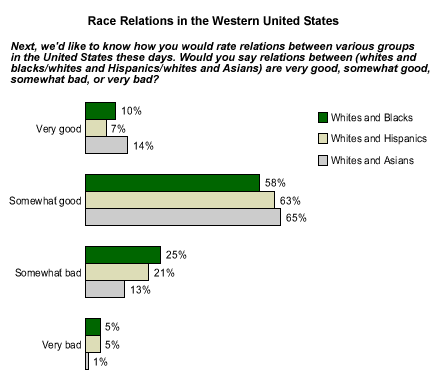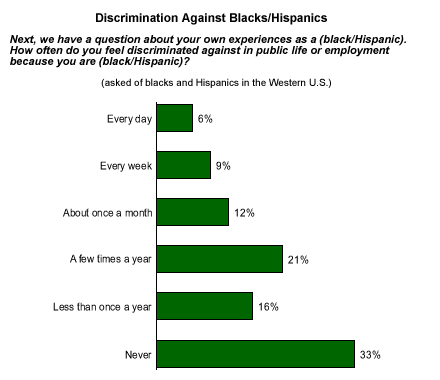This is the second article in a four-part series on race relations in four regions of the United States.
Last week, we examined the status of race relations in the eastern United States. This week, we travel to the other side of the country to study recent Gallup Poll results on attitudes about race in the western United States*, as well as racial dissimilarity indexes for several areas in this region. (For a discussion of the CensusScope dissimilarity index, please see "U.S. Race Relations by Region: The East" in Related Items.)
Gallup Data on Race Relations in the Western United States
Residents of the western United States are more positive about relations among different races than those in the East, but slightly less positive than those in the Midwest and South. Gallup Poll results** indicate that 10% of those in Western states believe that relations between whites and blacks are "very good" and 58% think they are "somewhat good." Twenty-five percent report that relations between these two racial groups are "somewhat bad" and 5% believe they are "very bad."
With regard to relations between whites and Hispanics, attitudes among those in the Western states are similar to those for the overall U.S. population, despite the fact that dissimilarity indexes suggest a higher average level of residential integration among urban areas in this part of the country. Seventy percent of Gallup respondents report that relations between these two groups are either very (7%) or somewhat (63%) good. Twenty-one percent report that relations between whites and Hispanics are somewhat bad and 5% say very bad.
There is a significant Asian population in the Western states, and relations between whites and Asians are the most positive of the groups considered (as is the case in the other regions). Fourteen percent believe that relations between these two groups are very good and 65% say they are somewhat good. Only 13% report that relations between whites and Asians are somewhat bad and 1% call them very bad.

The relatively high level of integration may be best reflected in the responses of Western Americans regarding job opportunities and overt discrimination toward racial minorities. When asked if they feel that racial minorities have equal job opportunities to whites, 51% of Western residents said yes -- the highest response for any of the four regions and a shade higher than the national average (48%). When questioning black and Hispanic respondents specifically about their own experiences, 33% of those in Western states say they never feel discriminated against in public life or employment because of their race or ethnicity. This figure is higher than that found in any other region in the United States. Nationally, the figure is 29%.

Dissimilarity Indexes for Western Metropolitan Areas
In the eastern United States, three major metropolitan centers fall into the top 10 least integrated in the country, according to CensusScope's ranking of dissimilarity indexes for U.S. metropolitan areas. The situation is much more positive in the West: only four major metropolitan areas in the region fall into the top 100 dissimilarity indexes. None of these scores are in the top 50, indicating that in this part of the country, people of different races and ethnicities are more likely to inhabit the same neighborhoods.
Three of the four Western metropolitan areas that score among the 100 highest dissimilarity indexes (Los Angeles/Long Beach, Denver, Oakland and San Francisco) are in California. The highest dissimilarity index between blacks and whites (70.5) is in Los Angeles/Long Beach, which places this metropolitan area at No. 53 in the ranking of indexes. Almost half of the population of this area (45%) is Hispanic, and the dissimilarity rate between whites and Hispanics (64.4) is more positive than the one between whites and blacks. Even more positive, the dissimilarity index between whites and Asians is 51.8.
Denver, with a white/black dissimilarity index of 66.2, ranks 86th among the 318 metropolitan areas ranked. With a Hispanic population of almost 20%, Denver's dissimilarity index between whites and Hispanics is relatively low at 51.8. In San Francisco, where Asians make up more than a fifth (22.5%) of the population, the dissimilarity index between whites and Asians is relatively low, at 52.
The opposite end of the scale gives another perspective on the state of racial integration in California: Sacramento ranks as one of the most integrated metropolitan areas in the country, with a black/white index of 59.6 (150th in the ranking). The Sacramento white/Hispanic dissimilarity index is also quite low at 41.2.

Key Points
The idea that members of different races or ethnicities are more likely to see each other in a positive light, and to perceive that they have equal opportunities to one another when they are living together in the same neighborhoods, may be best reflected in the Western part of the United States. Gallup data on racial perceptions, as well as CensusScope dissimilarity index data, are both most favorable to minority populations in this part of the country.
*Montana, Arizona, Colorado, Idaho, Wyoming, Utah, Nevada, New Mexico, California, Oregon and Washington
**Results are based on telephone interviews with 1,360 national adults, aged 18 and older, conducted June 3-9, 2002, including oversamples of blacks and Hispanics that are weighted to reflect their proportions in the general population. For results based on the total sample of national adults, one can say with 95% confidence that the maximum margin of sampling error is ±3%.
